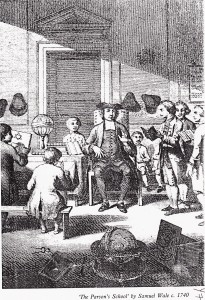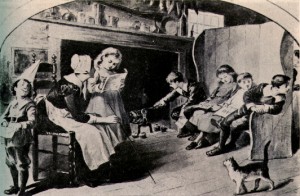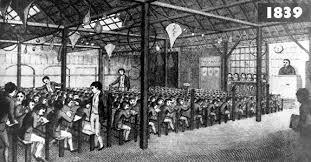The range and nature of instructional methods used by teachers with students has a long history. Most teachers adapt variably from this historical bank of teaching theory and methods. In this sense every teacher teaches differently. Nevertheless there are a number of basic approaches that have been used in schools since the British colonisation of Australia from the late eighteenth century. The words ‘teaching’ and ‘pedagogy overlap in meaning, with pedagogy including the idea not only of practice, but theories and guidance about how to teach. Please note that this entry does not address Indigenous pedagogies.
How teaching occurs is rarely a straightforward application of any theoretical method. The social character of schools, the prior learning experiences of students, the means by which teachers are judged successful or not, and the character of student assessment and more, each powerfully affects pedagogy. In some places, particular forms of instruction are considered more legitimate than others, made powerful by tradition.
This entry does not cover the topic in detail. From the eighteenth century and before, a range of philosophers, religious leaders and educators put forward different ideas about how education and schooling ought to take place. Among the many are Ignatius Loyola, Jean-Jacques Rousseau, Philipp von Fellenberg, Johann Pestalozzi and David Stow for example. Each of these and many others influenced pedagogy at particular sites in Australia. The concentration in this entry is on two of the more significant broad teaching approaches that were used in Australian schools through to 1850. The focus is rather more on elementary than post-elementary education.
In what follows there are at least five questions that are addressed for each pedagogic approach:
- What theory of how a child or youth learns is being engaged?
- What is the teacher’s role in the learning plan?
- What texts and apparatus assist the teaching?
- What kind of school architecture is required?
- What are the main social assumptions associated with this approach to teaching?
The ‘individual’ method of teaching
The individual method is the least theorised, and the oldest approach to teaching. It precedes ideas such as age-grading, that is, the idea that young people should learn with others of the same age. It also precedes the idea that young people should be grouped according to roughly common sets of prior learning or having achieved certain standards. The individual method certainly allows for intensive one-on-one instruction, but the individual method also occurs in groups. If in groups, young people are often learning different things, or they are at different points in the process of learning. Pupils’ main point of reference is the teacher who supervises their individual progress.
This form of teaching can be traced back as far as ancient societies. It was not only adaptable to teaching both elementary and post-elementary curricula, but groups from different social backgrounds. Here, discussion of the individual method encompasses the teaching of groups and individuals from wealthier and labouring classes.
(1) Individual method for middling and upper classes
In the absence of suitable schools for children of the exclusivist and wealthier white families in New South Wales in the late eighteenth and early nineteenth centuries, governesses and tutors were often employed to instruct children in their homes. Very early on some of these were convicts. Sometimes children from more than one family would come together with such a teacher.
Children and youth were often engaged individually, with different learning tasks. Figure 1 is an English representation of the individual method at work. In this case, as often occurred in early colonial Australia, a local clergyman for example could supplement his income by taking students. In this case the work appears to be post-elementary.
The characteristics of the individual method are plainly seen. Students are not necessarily the same age, and they are doing different things. One appears to be engaged in geometry, others are not. The students are spread about informally. It is likely that this is what is occurring: students are asked to read and learn a page from a textbook, or perform a particular task. When a student believes he has mastered or learned that required of him, he goes to the teacher who tests him on the material. It may be geometric theorems (Euclid), or Latin or Greek vocabulary or grammar. There appears to be some astronomy occurring here as well. Memorisation is engaged as a major learning tool. It is likely that much of that to be learned comes from textbooks of various kinds. Once the teacher considers the work learned, the pupil is likely set the next page of the textbook, or the next task to master.
There is a system to this form of teaching, but it does not depend on formal arrangements of teachers and learners, or common curricula or assessments being applied. It may be thought of as a pre-industrial form of instruction.
Except for a few, it was a form of teaching that was unlikely to survive mass compulsory school attendance. It is likely that it lasted longer for middle and upper class girls than boys. If girls were put into schools at all rather than being taught at home, their schools usually prided themselves on being small and homely, with a family atmosphere. The women who ran them often advertised their attention to individual pupils.
(2) Individual method for poorer and village children
Small private, one teacher schools, sometimes called ‘dame schools’ were common in Australia through the nineteenth century, even after the introduction of public schools. In the ‘dame school’ form, there was usually one woman, more or less educated, who offered to teach her neighbours’ children their ‘letters’. It is a form of schooling we know little about because such arrangements were ephemeral. Such schools rarely made newspapers or publications, with the exception of the critical reports that state education department inspectors wrote about them from the 1870s, about how inefficient and disorganised they were. The reports told some truths, but they often hid the reason why they were attractive to the families that patronised them.
One of the reasons included a flexible approach to attendance. If parents needed their children to help with household, farm or other tasks, they could miss school without criticism. Older children could take their younger siblings to school. There was no separation of brothers and sisters on the grounds of age-grading or prior achievement. Children could be looked after in such a school, away for a few hours from their busy parents. Along with this went learning some reading and perhaps a little writing and arithmetic. Standards were not high, but why did poor farmers or young people destined for unskilled labouring work need more than basic literacy? The fees were low. These were schools attuned to the ‘rhythms of rural and working class life’. They began to contrast greatly with the emerging national and public schools from the 1850s that systematised schools and increasingly regulated teacher training, curricula and teaching practices.
The teaching that occurred in the dame schools was individual. Some children might be learning the alphabet, others simple or complex words, others might be beginning to put sentences together. The teacher might help them where and when she could. The texts used in such teaching were hardly standardised. They could be primers, but a teacher likely collected reading materials from several sources. Sometimes church catechisms for children were used. Public school inspectors and churches criticised these schools. Both often agreed that the moral training of children was probably lax, and the churches doubted that much useful religious education occurred. In Figure 2, this time an image from eighteenth century America, one can readily see the homely atmosphere, the range of children of different ages, and the likelihood that most children were doing things other than what their fellows were. Parents and teachers were neighbours, and ‘equals’ in this kind of schooling; a great contrast to the kinds of schooling that dominated by the end of the nineteenth century.
(3) Legacies of the individual method for the present
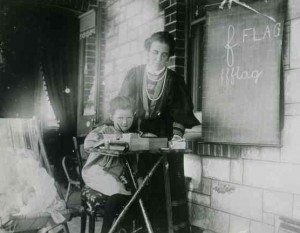
Figure 3: Alison Ashby being taught at home by her Aunt ‘Meta’ (individual instruction), Blackwood, South Australia. State Library of South Australia, B 48797
In the late twentieth century ‘home schooling’ occurred in increasing numbers of families. Usually the mother educated her own children of different ages, interests and educational attainments. The individual method necessarily operates under such circumstances, though the levels of education, and the quality of educational materials and activities is likely to be considerably better than nineteenth century versions of the ‘method’ allowed.
The individual method may also be seen in very small group coaching and tutoring, usually occurring as an adjunct to main-stream schooling, either to assist students ‘falling behind’ their class-mates, or to advantage other students in their families’ quests for advantage in the pursuit of scholarships or entry into desired schools or universities. One may also see versions of the method in ordinary schools, perhaps through the withdrawal of students from classrooms to work with adjunct teachers, assistants, or volunteer parents, for reading practice and a range of other activities. In some cases this is a model used for supplementing the education of so-called ‘gifted and talented’ students as well as those with learning difficulties and, in Australia, recent immigrants adjusting to their new cultural setting.
Monitorial schools and teaching
The second broad approach of importance in the early nineteenth century was monitorialism. It was a deliberate pedagogic innovation. Two versions of it came to the Australian colonies from England. One was invented by Andrew Bell, though he acknowledged Indian influences. It was especially taken up by colonial schools either operated by or within which the the Church of England was powerful. The other version was formulated by Joseph Lancaster, a Quaker. His monitorial plan was influential among dissenters from the Church of England, including Wesleyans (Methodists).
Monitorialism was peculiarly modern in advocating economies of scale and the efficient use of human resources. It was capable of imparting basic literacy and numeracy to substantial numbers of children. It was a form of schooling and pedagogy that appeared responsive to its age. It promised not only a useful elementary education, but effective discipline, and even moral education. Its appearance was contemporary in another respect. The rise of the factory and mass production was a characteristic of the industrial revolution. The monitorial school appeared to imitate factory methods in the mass production of literate children.The Lancasterian system was pioneered in New South Wales in 1811, the Bell system a little later. The monitorial system was fundamental not only to Protestant schools, but also to colonial Catholic schools some years later in Australia and New Zealand (particularly schools of the Marist and Christian Brothers, and Mercy sisters).
As Figure 4 shows, there was a schoolroom (not a set of classrooms) that contained many pupils, in some cases many more than a hundred. There was one supervising teacher. The pupils were divided into rows. In charge of each row was an older child or youth, the ‘monitor’. Monitors took instruction from the master teacher. They worked with the pupils in their row, sometimes taking them to one of the teaching stations ranged around the schoolroom (Figure 5). Students were grouped according to educational level, so that common lessons and exercises in reading, writing, arithmetic (ciphering), religion and so on could occur.
There was a primitive psychology embedded in this form of instruction. A set of rewards for work well done was applied. These could include tickets, books and pictures.
Because this was a form of schooling that could involve very large numbers of young people in a confined space, the orderly control of movement was of paramount concern. Whistles, bells, flags and hand signals were among the apparatus used to control the movement of children. Clear instructions concerning the child’s body were expected to be observed. How children’s work on slates was to be displayed for checking by monitors was part of this (Figure 6) as was how children were to stand and sit at their desks (Figure 7).
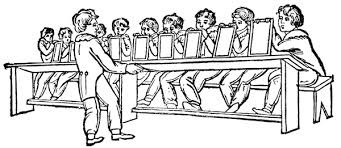
Figure 6: Work displayed for monitor’s inspection. From Manual of the British and Foreign School Society, London, 1831.
Thomas Bigge, the Commissioner sent in 1819 by the British Government to inquire into the administration of New South Wales under Governor Macquarie, made certain recommendations on how the colonial government should conduct the schools it supervised. He recommended the introduction of the Bell (or National) system of monitorial pedagogy to New South Wales.
This was not a surprise since the colonial chaplains belonged to the Church of England, and it was assumed by many that the Church of England was, or would be the established, or official church of the colony. At the same time, many teachers in the colony were Wesleyans, and some schools used Lancaster’s version as a result.
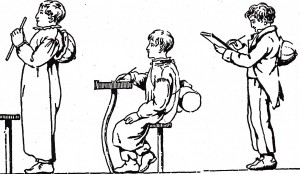
Figure 7: Pupil body positions. From Manual of the British and Foreign School Society, London, 1831.
These were the perceived advantages of monitorialism for the colonial schools of Australia:
- efficient use of scarce teachers
- efficient delivery of literacy, numeracy and moral/religious education
- social discipline among a problematic population of children from parents who were or had been convicts
3. Legacies of monitorialism into the present
These legacies include a systematic approach to teacher training, albeit under monitorialism it was through the apprentice model (monitors). Another legacy is the small, flashy reward, meant to reinforce positive classroom and learning behaviours. Today they might include gold, silver and bronze stars for good work, or certificates of various kinds. They include the rigid timetables by which many schools run, dividing lessons and non-lesson time by the ringing of bells, sirens and similar. Also important as a legacy is the idea of the systematic instruction of a large population through the economic use of human and other resources. Monitorialism also depended on mass produced readers and teaching aids. Succeeding pedagogic systems did the same.
Assessing these early nineteenth century forms of pedagogy
1. What theory of how a child or youth learns is being engaged?
No particular theory is engaged in the individual method. There were relatively few expectations about the rate by which particular content and skills might be learnt. It was simply a variation on the more or less informal teaching of useful knowledge to the young from earliest times.
Monitorialism was very different. Young people were expected to learn, by force if required. The child was often a passive recipient of the curriculum, which was graded to some extent. Memorisation was required, and rote learning engaged. But these had also been features of the individual method. The grading of children and the curriculum allowed for the possibility of common and collective learning, all children being expected to learn at roughly the same rate.
2. What is the teacher’s role in the learning involved?
For the individual method, the teacher supervises. He or she can be a didact (direct instructor), but often he or she introduces the work to be learned and then checks that it has. There is an informality to the teaching style and limited expectations of what the teacher ought to do with each child, or what results are to be expected. The teacher is more than likely ‘independent’, only subject to the expectations of client families rather than employers.
Under monitorialism both teacher and monitors are more clearly didactic. There are expectations that the teacher and monitors will exert strong control, and moralise pupils. It was expected that pupils taught this way would become literate in a short period of time. Ideally the teacher is ‘trained’ in the method. Monitor trainees were selected from pupil ranks, those identified as high performing pupils with the potential to instruct younger children.
3. What texts and apparatus assist the teaching?
Depending on the individual or group of pupils, and the experience, education and inclinations of the teacher, various texts and apparatus were used in the individual method. In 1800, primers and spelling lists had been available for younger children for a long time, as had catechisms (lists of questions and answers training young people in their religion). These may have been used with other reading materials in dame schools. Any number of texts in classical or vernacular languages may have been used for post-elementary children. Regular or standard apparatus was rare, but no doubt globes, maps and the like were occasionally used if available.
By contrast, monitorialism prided itself on materials and apparatus specifically produced for instruction. To assist the monitorial school established in Sydney’s male orphan institution in 1821 Governor Macquarie ordered these materials from London: Bibles, Testaments, 1,000 small slates, 2,000 slate pencils, 50 dozen black lead pencils, 1,000 sets of books, including the cards used in Bell’s system, 1,000 stereotyped cards of monosyllables, 100 dozen of written characters, 100 dozen of figures, 28 Bell’s instructions (to be given to the masters and mistresses), 200 prayer books, books for rewards and encouragement and a supply of paper and quills.
4. What kind of school architecture is required?
No specific architecture was required for individual teaching. A space with some seating, usually indoors, was all that was required. For monitorialism however, a large schoolroom, designed to take the regulated activities of the school was crucial.
5. What are the main social assumptions associated with these approaches to teaching?
For the individual method, there were cultural transmission and custodial expectations and assumptions involved. These varied according to social class and the gendered expectations of the instruction involved.
Monitorialism required a much more organised approach. In the early colonial schools social discipline or social control was an expectation. There was a belief that all children, rich or poor should have basic literacy, so monitorialism represented an early stage in the developing idea of the colonial subject as literate and regulated enough to bring the children of convicts and the labouring classes out of their criminal pasts.
Monitorialism has attracted at least three strands of historiographical interest in recent times. First is the argument that monitorialism was a crucial means of ordering and controlling unruly children from the labouring classes in a period of history when ‘traditional’ and patriarchal society was being disrupted by the industrial revolution, and other revolutions, especially in Europe from 1789. The second argument is that in some countries, especially the southern European, with Catholic populations like Spain, monitorial schooling was engaged by secular liberals to break the power of the Roman Catholic church over populations. Making populations more literate, and therefore critical of the existing social order, was the aim. The third argument derives from readers of Michel Foucault, and it goes well beyond monitorialism. This incorporates the idea that innovative nineteenth century pedagogies were about the surveillance of potentially unruly populations, and the re-making of citizens who internalised new modes of self-discipline and in the process were ‘normalised’.

